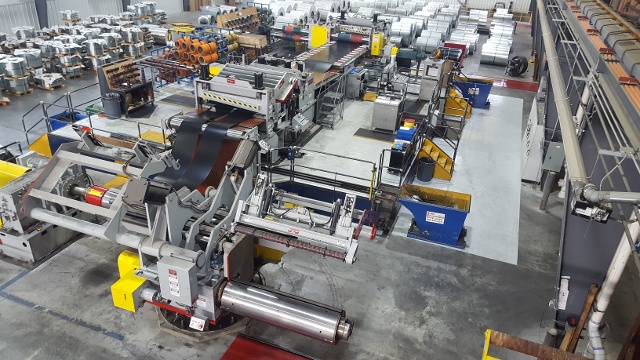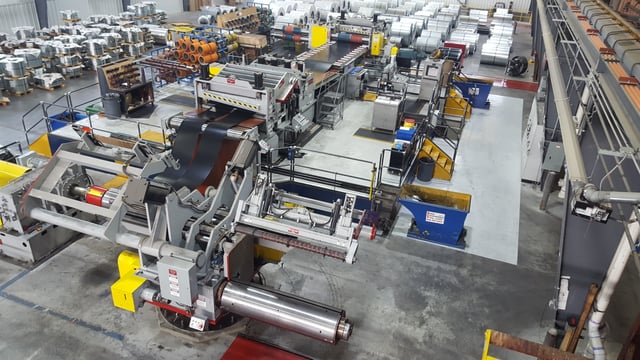

When deciding whether to upgrade metal slitter equipment, there are many factors that need to be considered. A metal slitter is a piece of machinery that takes sheet metal and cuts it into narrower widths depending on the needs of the customer and application. The Kloeckner Metals Tulsa, Oklahoma, facility can process coils of both ferrous and non-ferrous metal up to 60,000 pounds. The widths are typically between 10 and 72 inches wide but can go as low as .500”.
“We load the material on a rotating reel that allows the material to be threaded through the machine and slit to width,” says Charles Sudwischer, Regional Operations Manager at Kloeckner Metals Corporation.
The material is threaded through a pair of rotary arbors and steel knives that are precision ground for tight tolerance slitting. The single incoming width is cut into several strips of narrower widths. For example, a 48.500” inch wide sheet can be divided into four cuts of 12.00”. Once the sheet metal is slit, it is rolled back into coil form at the exit end of the line.
The most obvious consideration when buying new equipment is going to be the gauge capabilities. Kloeckner Metals primarily uses light gauge slitters, processing ferrous and non-ferrous material from .012” in thickness up to a .250”. Material thickness greater than .250” would be considered heavy gauge. Customer demands are going to dictate what gauge requirements are needed. Expanding gauge capabilities in your process can open up new customers, though.
“With the equipment we had previously, we could only process material to around .020” thick, and now we can go down to .012”, Sudwischer says. “That difference between .020” and .012” actually opened up a few customers to us that we couldn’t process in-house previously. Being able to process this material in-house gave us better control over the quality.”
On a similar note, new customers can create a need for new equipment. A company that primarily deals with light gauge applications might find a few contract customers that require heavy gauge material. If the demand is great enough, it could justify the capital expenditure for a new processing line. Additionally, once current machines reach capacity then new machines could become necessary to continue expanding your customer base.
“Return on investment is something that you definitely want to look at if you are considering buying a new slitter,” Sudwischer says. “What is it going to do as far as improving efficiency and lowering my manufacturing cost? Is it going to open up new markets that will lead to additional business?”
The other main factor which would necessitate new equipment would be that the current equipment is antiquated. At some point the maintenance and upkeep requirements of old equipment exceed the value of the machine. In other words, continuing to allocate capital to upgrade or keep an asset reliable no longer makes any sense.
Whatever the reasons for upgrading, the cost effectiveness of the new machinery should be a primary consideration when choosing a new machine. Throughput is a major factor, especially when comparing a new machine to older machines.
“Our older lines only ran about four or five hundred feet per minute, versus a thousand now,” Sudwischer says. “That difference in speed allows for greater throughput which can reduce labor hours and/or increase capacity.”
Advances in technology have also improved the ergonomics of the machines. Modern equipment is more user-friendly. This translates into more satisfied employees, which helps with employee retention.
“That’s a little more difficult to measure as far as cost savings, but there is no doubt that employee turnover is a significant cost in business,” Sudwischer says.
Greater automation can go a long way to reducing costs and increasing efficiency. Auxiliary equipment can complement a slitting line and make the process more efficient. The Kloeckner Tulsa facility utilizes a leveler and a turret recoiler, for example. When the material arrives from the mill with a wavy edge or some other shape related defect, the leveler will flatten the steel to meet the flatness specifications of the valued customer. The turret recoiler, on the other hand, reduces downtime when removing finished product from the line. Once the reel is full, the turret rotates 180 degrees, opening up allowing the second recoiler to accept incoming strip. This entire process takes less than 4 minutes which is a 70% improvement from the time required by the processing lines we utilized previously.
“These efficiencies are not part of an OEM’s standard package, however, and come at a significant cost. The turret recoiler and the leveler were 25% of the total cost for the line,” Sudwischer says.
State of the art slitting lines also provide for better equipment guarding through the use of not only physical guarding but also interlocks and laser scanners. The advancements in guarding technology over the past decade that most OEM’s are now including as part of their standard equipment have made slitting lines much safer for workers to interface with on a daily basis.
All of these factors should play a part when a company decides to upgrade its slitting line. Fundamentally, it comes down to whether the long term cost effectiveness merits the capital expense. These are all ways to measure that cost effectiveness. If one considers all of these elements together, they will make the right choice for their slitting equipment.
Thanks for reading. If you enjoyed this article, you can read more like it on the Kloeckner Metals Blog.
![]()

Steel base plates are fundamental elements employed in various manufacturing...
Metal fabrication is a critical process that transforms raw metal...
The solar industry has undergone a significant transformation by incorporating...

X
The Kloeckner Metals website uses modern technologies. Unfortunately, your browser doesn't support those technologies.
Download the latest version of one of these browsers to experience the site: